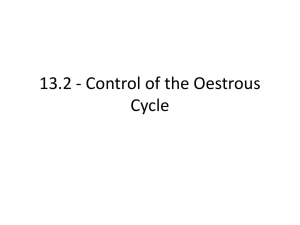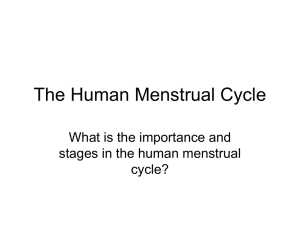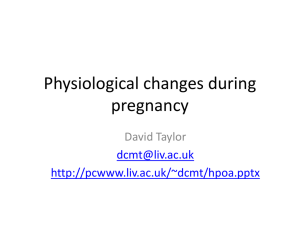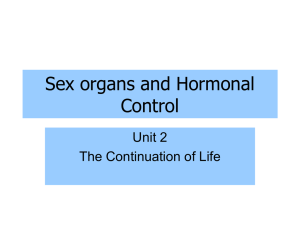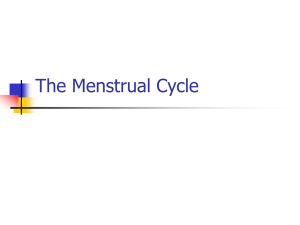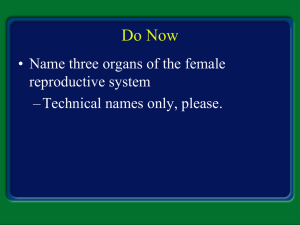ppt_E1ch04_hormonal control of reproductive cycles
advertisement
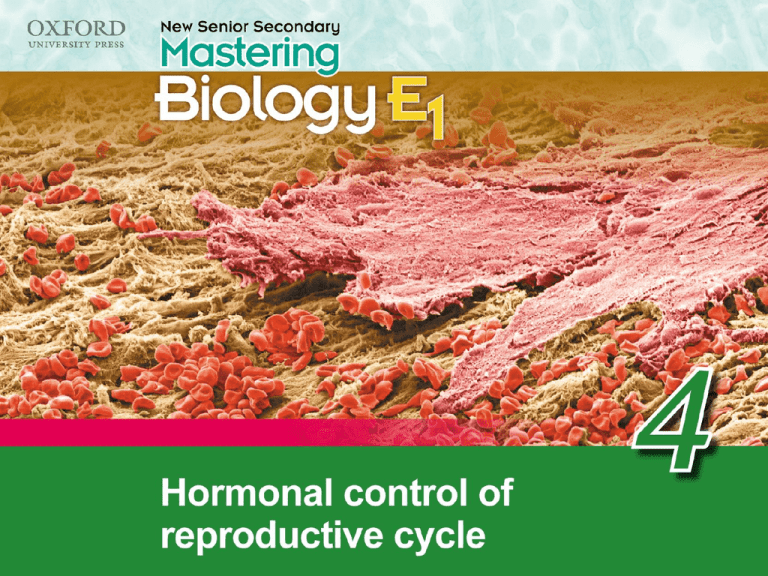
1 Think about… 4.1 Hormonal control of the menstrual cycle 4.2 Use of hormones Recall ‘Think about…’ Summary concept map 2 The performance of female athletes may be affected by their physiological conditions before or during menstruation. 3 Some athletes may take drugs to prevent menstruation from occurring during sports games. 4 The drugs contain hormones which are similar to those naturally produced in the female body. What are the hormones involved? How do the drugs prevent menstruation? Can menstruation be resumed later? 5 4.1 Hormonal control of the menstrual cycle Let’s revise the menstrual cycle first. 6 The menstrual cycle Cycle repeats until meno… 7 The maturation and release of egg cells from the ovary are synchronized with changes in the uterus 8 The Ovarian Cycle • In the ovarian cycle – Hormones stimulate follicle growth, which results in ovulation • Following ovulation – The follicular tissue left behind transforms into the corpus luteum Three phases: follicular --- ovulation --- luteal (1-14) (14) (14-28) 9 The Uterine Cycle Three phases : Menstrual -- proliferative ------- secretory (1-6) (6-14) (14-28) 10 4.1 Hormonal control of the menstrual cycle Day 1 to 5 of the menstrual cycle • uterine lining breaks down • follicle begins to develop 11 4.1 Hormonal control of the menstrual cycle Day 5 to 14 of the menstrual cycle • uterine lining begins to thicken • follicle becomes mature 12 4.1 Hormonal control of the menstrual cycle Day 14 of the menstrual cycle • uterine lining becomes very thick • ovulation occurs 13 4.1 Hormonal control of the menstrual cycle Day 14 to 28 of the menstrual cycle • uterine lining remains thick • ovum is moved along the oviduct 14 4.1 Hormonal control of the menstrual cycle What are the hormones involved? 15 4.1 Hormonal control of the menstrual cycle • events synchronized by the interaction of four hormones: pituitary gland follicle stimulating hormone (FSH) luteinising hormone (LH) 16 4.1 Hormonal control of the menstrual cycle • events synchronized by the interaction of four hormones: yellow body follicle oestrogen 17 4.1 Hormonal control of the menstrual cycle • events synchronized by the interaction of four hormones: yellow body progesterone 18 4.1 Hormonal control of the menstrual cycle How do the hormones interact? • the hormones interact by feedback mechanisms 19 4.1 Hormonal control of the menstrual cycle ovary pituitary gland stimulation FSH 20 4.1 Hormonal control of the menstrual cycle pituitary gland ovary follicle develops 21 4.1 Hormonal control of the menstrual cycle pituitary gland ovary Above a certain level, oestrogen stimulates FSH and LH secretion 22 4.1 Hormonal control of the menstrual cycle pituitary gland ovary LH LH stimulates oestrogen secretion and oestrogen stimulates FSH and LH secretion …. A positive feedback effect at around day 14 that raise LH to a peak level 23 4.1 Hormonal control of the menstrual cycle pituitary gland ovary ovulation 24 4.1 Hormonal control of the menstrual cycle pituitary gland ovary yellow body LH stimulates development of yellow body and hence progesterone secretion 25 4.1 Hormonal control of the menstrual cycle pituitary gland inhibition ovary oestrogen and progesterone together inhibit LH and FSH 26 4.1 Hormonal control of the menstrual cycle Let’s look at the menstrual cycle from day 5. 27 4.1 Hormonal control of the menstrual cycle Before ovulation 1 The pituitary gland secretes FSH. 2 FSH stimulates the development of follicles. As the follicle matures, it secretes more oestrogen. 3 Under the action of oestrogen, the uterine lining begins to thicken. to chart 28 4.1 Hormonal control of the menstrual cycle Before ovulation 4 Oestrogen level continues to rise and reaches a peak just before ovulation. A high level of oestrogen stimulates FSH and LH secretion. The peaks of FSH and LH occur just after the oestrogen peak. 5 A high level of LH causes ovulation to occur on day 14. to chart 29 4.1 Hormonal control of the menstrual cycle After ovulation 6 The remaining follicle cells form the yellow body. A high level of LH stimulates the yellow body to secrete oestrogen and progesterone. Oestrogen level rises again and progesterone level reaches a peak. 7 Under the action of oestrogen and progesterone, the uterine lining to chart remains thick. 30 4.1 Hormonal control of the menstrual cycle After ovulation 8 High levels of oestrogen and progesterone together inhibit FSH and LH secretion. A low level of LH causes the yellow body to degenerate around day 24. to chart 31 4.1 Hormonal control of the menstrual cycle After ovulation 9 The yellow body gradually stops secreting oestrogen and progesterone and the thickened uterine lining soon breaks down. Also, the inhibition of oestrogen and progesterone on FSH secretion is removed. The pituitary gland secretes more FSH again and the cycle repeats. to chart 32 4.1 Hormonal control of the menstrual cycle levels of pituitary hormones in blood events in ovary levels of ovarian hormones in blood thickness of uterine lining to text 33 • Cyclic secretion of GnRH* from the hypothalamus – And of FSH and LH from the anterior pituitary orchestrates the female reproductive cycle Five hormones involved in an elaborate scheme involving both positive and negative feedback *Gonadotropin-releasing hormone 34 Hormone Site of Secretion Follicle Pituitary Stimulating gland Hormone (FSH) Oestrogen Ovary Lutenising Pituitary Hormone (LH) Progestrone Corpus luteum Target Organ Function •stimulates the growth & development of the follicle Ovary •stimulates secretion of oestrogen •effect of LH in stimulating ovulation •stimulates repair of uterine lining Endometrium •at high conc. inhibits FSH, however during (lining of the 'pituitary hormone surge' it stimulates further uterus) FSH production •as conc. peaks stimulates release of LH Ovary •stimulates the final development of the follicle •stimulates ovulation •stimulates the development of the corpus luteum •stimulates production of progesterone Uterus •maintains uterine lining endometrium) •inhibits release of FSH •inhibits release of LH •fall in conc. results in menstruation •fall in conc. removes inhibition of FSH and a new cycle begins. 35 Feedback control of human menstrual cycle 36 Atresia of corpus luteum -- degeneration and resorption of corpus luteum in ovary Estradiol -- Oestrogen Hormonal feedback control of menstrual cycle 37 • The reproductive cycle of the human female 38 • The reproductive cycle of the human female 39 4.1 Hormonal control of the menstrual cycle If fertilization occurs … placenta secretes human chorionic gonadotrophin (HCG) • acts like LH • prevents degeneration of yellow body secretes oestrogen and progesterone uterine lining remains thick for embryo development 40 4.1 Hormonal control of the menstrual cycle What is the significance of hormonal control of the menstrual cycle? 41 4.1 Hormonal control of the menstrual cycle i) Ensure one ovum is released at a time • after ovulation, high levels of oestrogen and progesterone together inhibit FSH and LH secretion prevents maturation of another follicle Higher survival chance! 42 4.1 Hormonal control of the menstrual cycle i) Ensure one ovum is released at a time • after ovulation, high levels of oestrogen and progesterone together inhibit FSH and LH secretion prevents maturation of another follicle Avoid wasting of energy! 43 4.1 Hormonal control of the menstrual cycle ii) Prepare for implantation • oestrogen and progesterone stimulate the thickening of the uterine lining 44 4.1 Hormonal control of the menstrual cycle iii) Prepare for the next possible pregnancy • if no fertilization occurs, levels of oestrogen and progesterone fall which causes menstruation to occur and the pituitary gland secretes more FSH again • the menstrual cycle repeats 45 4.1 Hormonal control of the menstrual cycle 1 Hormonal control of menstrual cycle: 46 4.1 Hormonal control of the menstrual cycle 2 Significance of hormonal control of the menstrual cycle: a After ovulation, high levels of oestrogen and progesterone together inhibit FSH and LH secretion. 47 4.1 Hormonal control of the menstrual cycle 2 Significance of hormonal control of the menstrual cycle: a This prevents the maturation of another follicle and ensures only one ovum is released in each cycle. This would result in higher survival chance of the foetus. 48 4.1 Hormonal control of the menstrual cycle 2 Significance of hormonal control of the menstrual cycle: b Oestrogen and progesterone stimulate the thickening of the uterine lining to prepare for the implantation of the embryo. 49 4.1 Hormonal control of the menstrual cycle 2 Significance of hormonal control of the menstrual cycle: c If no fertilization occurs, levels of oestrogen and progesterone fall which causes menstruation to occur. The pituitary gland begins to secrete more FSH again. 50 4.1 Hormonal control of the menstrual cycle 2 Significance of hormonal control of the menstrual cycle: c The menstrual cycle repeats to prepare for the next possible pregnancy. 51 4.2 Use of hormones • used as contraceptives or in the treatments of infertility 52 4.2 Use of hormones How are hormones used to prevent pregnancy? • contraceptive pills contain synthetic progesterone or a combination of synthetic oestrogen and progesterone high levels inhibit FSH and LH secretion follicle development and ovulation do not occur 53 4.2 Use of hormones contraceptive pills for 21 days for 28 days hormone-free 54 4.2 Use of hormones contraceptive patches and injections to be replaced weekly to be taken every 3 months 55 How the injection works (ref) • • • • • The contraceptive injection works in the same way as the implant. It steadily releases the synthetic hormone progestogen into your bloodstream. The continuous release of progestogen: stops a woman releasing an egg every month (ovulation) thickens the mucus from the cervix (neck of the womb), making it difficult for sperm to pass through to the womb and reach an unfertilised egg makes the lining of the womb thinner so that it is unable to support a fertilised egg Disrupted periods • Periods irregular and may be very heavy, or shorter and lighter, or stop altogether. This may settle down after the first year, but may continue as long as the injected progestogen remains in your body. • It can take a while for your periods and natural fertility to return after you stop using the injection. It takes around eight to 12 weeks for injected progestogen to leave the body, but you may have to wait longer for your periods to return to normal if you are trying to get pregnant. 56 4.2 Use of hormones • morning-after pills contain a high dose of synthetic progesterone or a combination of synthetic oestrogen and progesterone prevent ovulation and implantation prevent pregnancy after sexual intercourse 57 4.2 Use of hormones They are not for regular use and must be prescribed by doctors. 58 4.2 Use of hormones How are hormones used to treat infertility? • causes of infertility: - does not produce enough sperm - sperm have low motility - sperm have structural defects 59 4.2 Use of hormones How are hormones used to treat infertility? • causes of infertility: - fails to release ova from the ovaries - oviducts are blocked - uterine environment does not allow implantation 60 4.2 Use of hormones • fertility drugs contain: - FSH stimulates follicle development 61 4.2 Use of hormones • fertility drugs contain: - LH stimulates ovulation 62 4.2 Use of hormones • fertility drugs contain: - synthetic oestrogen and progesterone stimulates the thickening of the uterine lining to prepare for implantation of the embryo 63 4.2 Use of hormones 1 Synthetic oestrogen and progesterone are present in contraceptives. They inhibit FSH and LH secretion by the pituitary gland. This prevents follicle development and ovulation, so that no ova are released into the oviducts for fertilization. 64 4.2 Use of hormones 2a FSH, LH, HCG , synthetic oestrogen and progesterone are present in fertility drugs. 65 4.2 Use of hormones 2b FSH promotes follicle development. LH and HCG stimulate ovulation . Synthetic oestrogen and progesterone stimulate the thickening of the uterine lining to prepare for implantation . 66 1 What are the hormones present in the drugs? The drugs contain synthetic oestrogen and progesterone. 67 2 How do the drugs prevent menstruation? High levels of oestrogen and progesterone in blood maintain the thickness of the uterine lining to prevent menstruation. 68 3 How can menstruation be resumed? Menstruation will resume after the female has stopped taking the drugs. 69 Menstrual cycle is controlled by interaction of pituitary hormones ovarian hormones can be used as contraceptives treatment of fertility 70 pituitary hormones include follicle stimulating hormone (FSH) stimulates follicle development luteinising hormone (LH) ovulation stimulates yellow body formation 71 ovarian hormones include oestrogen progesterone stimulate thickening of uterine lining low levels cause menstruation to prepare for implantation 72
